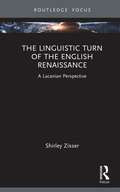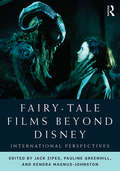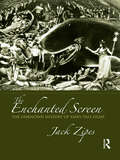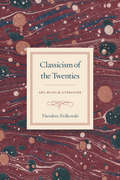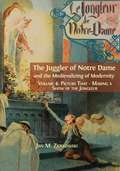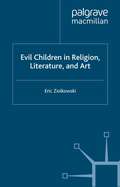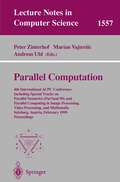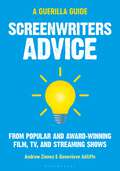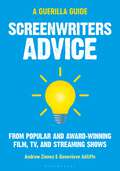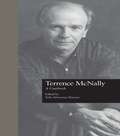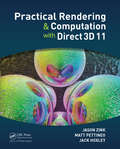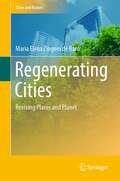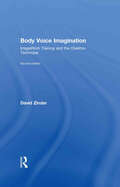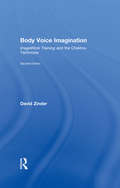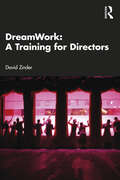- Table View
- List View
The Linguistic Turn of the English Renaissance: A Lacanian Perspective (Routledge Focus on Mental Health)
by Shirley ZisserThe Linguistic Turn of the English Renaissance: A Lacanian Perspective examines a selection of cultural phenomena of the English Renaissance, all of which include a focus on language, from a Lacanian perspective. The book examines four inter-related cultural symptoms of the English Renaissance: the paucity of painting, the interest in rhetoric, the emergence of a literary style focusing on form and a fascination with the myth of Orpheus. The book argues that the English Renaissance, an apex of rhetorical theory, can offer psychoanalysis further knowledge concerning the intrication of language and flesh, especially where feminine jouissance is at stake. These language-centred phenomena emerge against the backdrop of a peculiar configuration of the visual field, which in contrast to other cultures of the European Renaissance is largely barren of painting other than portraiture. The book will be of interest to psychoanalysts, scholars of Renaissance culture and those interested in the psychoanalytic study of culture.
The Linguistic Turn of the English Renaissance: A Lacanian Perspective (Routledge Focus on Mental Health)
by Shirley ZisserThe Linguistic Turn of the English Renaissance: A Lacanian Perspective examines a selection of cultural phenomena of the English Renaissance, all of which include a focus on language, from a Lacanian perspective. The book examines four inter-related cultural symptoms of the English Renaissance: the paucity of painting, the interest in rhetoric, the emergence of a literary style focusing on form and a fascination with the myth of Orpheus. The book argues that the English Renaissance, an apex of rhetorical theory, can offer psychoanalysis further knowledge concerning the intrication of language and flesh, especially where feminine jouissance is at stake. These language-centred phenomena emerge against the backdrop of a peculiar configuration of the visual field, which in contrast to other cultures of the European Renaissance is largely barren of painting other than portraiture. The book will be of interest to psychoanalysts, scholars of Renaissance culture and those interested in the psychoanalytic study of culture.
Fairy-Tale Films Beyond Disney: International Perspectives
by Jack Zipes Pauline Greenhill Kendra Magnus-JohnstonThe fairy tale has become one of the dominant cultural forms and genres internationally, thanks in large part to its many manifestations on screen. Yet the history and relevance of the fairy-tale film have largely been neglected. In this follow-up to Jack Zipes’s award-winning book The Enchanted Screen (2011), Fairy-Tale Films Beyond Disney offers the first book-length multinational, multidisciplinary exploration of fairy-tale cinema. Bringing together twenty-three of the world’s top fairy-tale scholars to analyze the enormous scope of these films, Zipes and colleagues Pauline Greenhill and Kendra Magnus-Johnston present perspectives on film from every part of the globe, from Hayao Miyazaki’s Spirited Away, to Jan Švankmajer’s Alice, to the transnational adaptations of 1001 Nights and Hans Christian Andersen. Contributors explore filmic traditions in each area not only from their different cultural backgrounds, but from a range of academic fields, including criminal justice studies, education, film studies, folkloristics, gender studies, and literary studies. Fairy-Tale Films Beyond Disney offers readers an opportunity to explore the intersections, disparities, historical and national contexts of its subject, and to further appreciate what has become an undeniably global phenomenon.
Fairy-Tale Films Beyond Disney: International Perspectives
by Jack Zipes Pauline Greenhill Kendra Magnus-JohnstonThe fairy tale has become one of the dominant cultural forms and genres internationally, thanks in large part to its many manifestations on screen. Yet the history and relevance of the fairy-tale film have largely been neglected. In this follow-up to Jack Zipes’s award-winning book The Enchanted Screen (2011), Fairy-Tale Films Beyond Disney offers the first book-length multinational, multidisciplinary exploration of fairy-tale cinema. Bringing together twenty-three of the world’s top fairy-tale scholars to analyze the enormous scope of these films, Zipes and colleagues Pauline Greenhill and Kendra Magnus-Johnston present perspectives on film from every part of the globe, from Hayao Miyazaki’s Spirited Away, to Jan Švankmajer’s Alice, to the transnational adaptations of 1001 Nights and Hans Christian Andersen. Contributors explore filmic traditions in each area not only from their different cultural backgrounds, but from a range of academic fields, including criminal justice studies, education, film studies, folkloristics, gender studies, and literary studies. Fairy-Tale Films Beyond Disney offers readers an opportunity to explore the intersections, disparities, historical and national contexts of its subject, and to further appreciate what has become an undeniably global phenomenon.
The Enchanted Screen: The Unknown History of Fairy-Tale Films
by Jack ZipesThe Enchanted Screen: The Unknown History of Fairy-Tale Films offers readers a long overdue, comprehensive look at the rich history of fairy tales and their influence on film, complete with the inclusion of an extensive filmography compiled by the author. With this book, Jack Zipes not only looks at the extensive, illustrious life of fairy tales and cinema, but he also reminds us that, decades before Walt Disney made his mark on the genre, fairy tales were central to the birth of cinema as a medium, as they offered cheap, copyright-free material that could easily engage audiences not only though their familiarity but also through their dazzling special effects. Since the story of fairy tales on film stretches far beyond Disney, this book, therefore, discusses a broad range of films silent, English and non-English, animation, live-action, puppetry, woodcut, montage (Jim Henson), cartoon, and digital. Zipes, thus, gives his readers an in depth look into the special relationship between fairy tales and cinema, and guides us through this vast array of films by tracing the adaptations of major fairy tales like "Little Red Riding Hood," "Cinderella," "Snow White," "Peter Pan," and many more, from their earliest cinematic appearances to today. Full of insight into some of our most beloved films and stories, and boldly illustrated with numerous film stills, The Enchanted Screen, is essential reading for film buffs and fans of the fairy tale alike.
The Enchanted Screen: The Unknown History of Fairy-Tale Films
by Jack ZipesThe Enchanted Screen: The Unknown History of Fairy-Tale Films offers readers a long overdue, comprehensive look at the rich history of fairy tales and their influence on film, complete with the inclusion of an extensive filmography compiled by the author. With this book, Jack Zipes not only looks at the extensive, illustrious life of fairy tales and cinema, but he also reminds us that, decades before Walt Disney made his mark on the genre, fairy tales were central to the birth of cinema as a medium, as they offered cheap, copyright-free material that could easily engage audiences not only though their familiarity but also through their dazzling special effects. Since the story of fairy tales on film stretches far beyond Disney, this book, therefore, discusses a broad range of films silent, English and non-English, animation, live-action, puppetry, woodcut, montage (Jim Henson), cartoon, and digital. Zipes, thus, gives his readers an in depth look into the special relationship between fairy tales and cinema, and guides us through this vast array of films by tracing the adaptations of major fairy tales like "Little Red Riding Hood," "Cinderella," "Snow White," "Peter Pan," and many more, from their earliest cinematic appearances to today. Full of insight into some of our most beloved films and stories, and boldly illustrated with numerous film stills, The Enchanted Screen, is essential reading for film buffs and fans of the fairy tale alike.
Classicism of the Twenties: Art, Music, and Literature
by Theodore ZiolkowskiThe triumph of avant-gardes in the 1920s tends to dominate our discussions of the music, art, and literature of the period. But the broader current of modernism encompassed many movements, and one of the most distinct and influential was a turn to classicism. In Classicism of the Twenties, Theodore Ziolkowski offers a compelling account of that movement. Giving equal attention to music, art, and literature, and focusing in particular on the works of Stravinsky, Picasso, and T. S. Eliot, he shows how the turn to classicism manifested itself. In reaction both to the excesses of neoromanticism and early modernism and to the horrors of World War I—and with respectful detachment—artists, writers, and composers adapted themes and forms from the past and tried to imbue their own works with the values of simplicity and order that epitomized earlier classicisms. By identifying elements common to all three arts, and carefully situating classicism within the broader sweep of modernist movements, Ziolkowski presents a refreshingly original view of the cultural life of the 1920s.
Classicism of the Twenties: Art, Music, and Literature
by Theodore ZiolkowskiThe triumph of avant-gardes in the 1920s tends to dominate our discussions of the music, art, and literature of the period. But the broader current of modernism encompassed many movements, and one of the most distinct and influential was a turn to classicism. In Classicism of the Twenties, Theodore Ziolkowski offers a compelling account of that movement. Giving equal attention to music, art, and literature, and focusing in particular on the works of Stravinsky, Picasso, and T. S. Eliot, he shows how the turn to classicism manifested itself. In reaction both to the excesses of neoromanticism and early modernism and to the horrors of World War I—and with respectful detachment—artists, writers, and composers adapted themes and forms from the past and tried to imbue their own works with the values of simplicity and order that epitomized earlier classicisms. By identifying elements common to all three arts, and carefully situating classicism within the broader sweep of modernist movements, Ziolkowski presents a refreshingly original view of the cultural life of the 1920s.
Classicism of the Twenties: Art, Music, and Literature
by Theodore ZiolkowskiThe triumph of avant-gardes in the 1920s tends to dominate our discussions of the music, art, and literature of the period. But the broader current of modernism encompassed many movements, and one of the most distinct and influential was a turn to classicism. In Classicism of the Twenties, Theodore Ziolkowski offers a compelling account of that movement. Giving equal attention to music, art, and literature, and focusing in particular on the works of Stravinsky, Picasso, and T. S. Eliot, he shows how the turn to classicism manifested itself. In reaction both to the excesses of neoromanticism and early modernism and to the horrors of World War I—and with respectful detachment—artists, writers, and composers adapted themes and forms from the past and tried to imbue their own works with the values of simplicity and order that epitomized earlier classicisms. By identifying elements common to all three arts, and carefully situating classicism within the broader sweep of modernist movements, Ziolkowski presents a refreshingly original view of the cultural life of the 1920s.
Classicism of the Twenties: Art, Music, and Literature
by Theodore ZiolkowskiThe triumph of avant-gardes in the 1920s tends to dominate our discussions of the music, art, and literature of the period. But the broader current of modernism encompassed many movements, and one of the most distinct and influential was a turn to classicism. In Classicism of the Twenties, Theodore Ziolkowski offers a compelling account of that movement. Giving equal attention to music, art, and literature, and focusing in particular on the works of Stravinsky, Picasso, and T. S. Eliot, he shows how the turn to classicism manifested itself. In reaction both to the excesses of neoromanticism and early modernism and to the horrors of World War I—and with respectful detachment—artists, writers, and composers adapted themes and forms from the past and tried to imbue their own works with the values of simplicity and order that epitomized earlier classicisms. By identifying elements common to all three arts, and carefully situating classicism within the broader sweep of modernist movements, Ziolkowski presents a refreshingly original view of the cultural life of the 1920s.
The Juggler of Notre Dame and the Medievalizing of Modernity: Volume 4: Picture That: Making a Show of the Jongleur
by Jan M. ZiolkowskiThis ambitious and vivid study in six volumes explores the journey of a single, electrifying story, from its first incarnation in a medieval French poem through its prolific rebirth in the nineteenth and twentieth centuries. The Juggler of Notre Dame tells how an entertainer abandons the world to join a monastery, but is suspected of blasphemy after dancing his devotion before a statue of the Madonna in the crypt; he is saved when the statue, delighted by his skill, miraculously comes to life. Jan Ziolkowski tracks the poem from its medieval roots to its rediscovery in late nineteenth-century Paris, before its translation into English in Britain and the United States. The visual influence of the tale on Gothic revivalism and vice versa in America is carefully documented with lavish and inventive illustrations, and Ziolkowski concludes with an examination of the explosion of interest in The Juggler of Notre Dame in the twentieth century and its place in mass culture today. Volume 4 examines the famous Le jongleur de Notre Dame by the French composer Jules Massenet, which took Europe by storm after premiering in 1902 and then crossed the Atlantic to the impresario Oscar Hammerstein and the diva Mary Garden, who gave the opera new legs as a female juggler. Presented with great clarity and simplicity, Ziolkowski's work is accessible to the general reader, while its many new discoveries will be valuable to academics in such fields and disciplines as medieval studies, medievalism, philology, literary history, art history, folklore, performance studies, and reception studies.
The Juggler of Notre Dame and the Medievalizing of Modernity: Volume 6: War and Peace, Sex and Violence
by Jan M. ZiolkowskiThis ambitious and vivid study in six volumes explores the journey of a single, electrifying story, from its first incarnation in a medieval French poem through its prolific rebirth in the nineteenth and twentieth centuries. The Juggler of Notre Dame tells how an entertainer abandons the world to join a monastery, but is suspected of blasphemy after dancing his devotion before a statue of the Madonna in the crypt; he is saved when the statue, delighted by his skill, miraculously comes to life. Jan Ziolkowski tracks the poem from its medieval roots to its rediscovery in late nineteenth-century Paris, before its translation into English in Britain and the United States. The visual influence of the tale on Gothic revivalism and vice versa in America is carefully documented with lavish and inventive illustrations, and Ziolkowski concludes with an examination of the explosion of interest in The Juggler of Notre Dame in the twentieth century and its place in mass culture today. In this concluding volume, Ziolkowski explores the popularity of The Juggler of Notre Dame from the 1930s through the Second World War, especially in the Allied Resistance. Its popularity in the United States was subsequently maintained by figures as diverse as Tony Curtis and W. H. Auden, and although recently the story and medievalism have lost ground, the future of both holds promise. Presented with great clarity and simplicity, Ziolkowski's work is accessible to the general reader, while its many new discoveries will be valuable to academics in such fields and disciplines as medieval studies, medievalism, philology, literary history, art history, folklore, performance studies, and reception studies.
The Juggler of Notre Dame and the Medievalizing of Modernity: Volume 5: Tumbling into the Twentieth Century
by Jan M. ZiolkowskiThis ambitious and vivid study in six volumes explores the journey of a single, electrifying story, from its first incarnation in a medieval French poem through its prolific rebirth in the nineteenth and twentieth centuries. The Juggler of Notre Dame tells how an entertainer abandons the world to join a monastery, but is suspected of blasphemy after dancing his devotion before a statue of the Madonna in the crypt; he is saved when the statue, delighted by his skill, miraculously comes to life. Jan Ziolkowski tracks the poem from its medieval roots to its rediscovery in late nineteenth-century Paris, before its translation into English in Britain and the United States. The visual influence of the tale on Gothic revivalism and vice versa in America is carefully documented with lavish and inventive illustrations, and Ziolkowski concludes with an examination of the explosion of interest in The Juggler of Notre Dame in the twentieth century and its place in mass culture today. In this volume Jan Ziolkowski follows the juggler of Notre Dame as he cavorts through new media, including radio, television, and film, becoming closely associated with Christmas and embedded in children’s literature. Presented with great clarity and simplicity, Ziolkowski's work is accessible to the general reader, while its many new discoveries will be valuable to academics in such fields and disciplines as medieval studies, medievalism, philology, literary history, art history, folklore, performance studies, and reception studies.
The Juggler of Notre Dame and the Medievalizing of Modernity: Vol. 4: Picture That: Making a Show of the Jongleur (PDF)
by Jan M. ZiolkowskiThis ambitious and vivid study in six volumes explores the journey of a single, electrifying story, from its first incarnation in a medieval French poem through its prolific rebirth in the nineteenth and twentieth centuries. The Juggler of Notre Dame tells how an entertainer abandons the world to join a monastery, but is suspected of blasphemy after dancing his devotion before a statue of the Madonna in the crypt; he is saved when the statue, delighted by his skill, miraculously comes to life. Jan Ziolkowski tracks the poem from its medieval roots to its rediscovery in late nineteenth-century Paris, before its translation into English in Britain and the United States. The visual influence of the tale on Gothic revivalism and vice versa in America is carefully documented with lavish and inventive illustrations, and Ziolkowski concludes with an examination of the explosion of interest in The Juggler of Notre Dame in the twentieth century and its place in mass culture today. Volume 4 examines the famous Le jongleur de Notre Dame by the French composer Jules Massenet, which took Europe by storm after premiering in 1902 and then crossed the Atlantic to the impresario Oscar Hammerstein and the diva Mary Garden, who gave the opera new legs as a female juggler. Presented with great clarity and simplicity, Ziolkowski's work is accessible to the general reader, while its many new discoveries will be valuable to academics in such fields and disciplines as medieval studies, medievalism, philology, literary history, art history, folklore, performance studies, and reception studies.
Evil Children in Religion, Literature, and Art (Cross Currents in Religion and Culture)
by E. ZiolkowskiEvil Children in Religion, Literature and Art explores the genesis, development, and religious significance of a literary and iconographic motif, involving a gang of urchins, usually male, who mock or assault a holy or eccentric person, typically an adult. Originating in the biblical tale of Elisha's mockery (2 Kings 2.23-24), this motif recurs in literature, hagiography, and art, from antiquity up to our own time, strikingly defying the conventional Judeo-Christian and Romantic image of the child as a symbol of innocence.
Parallel Computation: 4th International ACPC Conference Including Special Tracks on Parallel Numerics (ParNum'99) and Parallel Computing in Image Processing, Video Processing, and Multimedia Salzburg, Austria, February 16-18, 1999, Proceedings (Lecture Notes in Computer Science #1557)
by Peter Zinterhof Marian Vajtersic Andreas UhlScreenwriters Advice: From Popular and Award Winning Film, TV, and Streaming Shows (The Guerilla Filmmaker’s Handbooks)
by Mr Andrew Zinnes Ms Genevieve JolliffeThis book looks at the most important part of the filmmaking process from the point of view of those who grind away at a keyboard or notepad trying to bring new ideas and perspectives to an increasingly diversified world. Using The Guerilla Film Makers Handbook's tried and true Q&A style, with selected screenwriters, creating an engaging and easily digestible conversational feel, this book chronicles story theory, formatting, business issues and the creative process itself. Whether you're a seasoned scribe or an inexperienced writer, this book will give you perspectives and tips to get your creative juices flowing and make your story happen.
Screenwriters Advice: From Popular and Award Winning Film, TV, and Streaming Shows (The Guerilla Filmmaker’s Handbooks)
by Mr Andrew Zinnes Ms Genevieve JolliffeThis book looks at the most important part of the filmmaking process from the point of view of those who grind away at a keyboard or notepad trying to bring new ideas and perspectives to an increasingly diversified world. Using The Guerilla Film Makers Handbook's tried and true Q&A style, with selected screenwriters, creating an engaging and easily digestible conversational feel, this book chronicles story theory, formatting, business issues and the creative process itself. Whether you're a seasoned scribe or an inexperienced writer, this book will give you perspectives and tips to get your creative juices flowing and make your story happen.
Terrence McNally: A Casebook (Casebooks on Modern Dramatists #No. 22)
by Toby Silverman ZinmanFirst Published in 1997. Routledge is an imprint of Taylor & Francis, an informa company.
Terrence McNally: A Casebook (Casebooks on Modern Dramatists)
by Toby Silverman ZinmanFirst Published in 1997. Routledge is an imprint of Taylor & Francis, an informa company.
Practical Rendering and Computation with Direct3D 11
by Jason Zink Matt Pettineo Jack HoxleyDirect3D 11 offers such a wealth of capabilities that users can sometimes get lost in the details of specific APIs and their implementation. While there is a great deal of low-level information available about how each API function should be used, there is little documentation that shows how best to leverage these capabilities. Written by active me
Regenerating Cities: Reviving Places and Planet (Cities and Nature)
by Maria Elena Zingoni de BaroThis book sets out the discussion on how cities can contribute solutions to some of the challenges the urbanised world is facing, such as the pressure of growing populations, mitigation of effects of, and adaptation to globally changing environmental, climate and public health conditions. Presenting a detailed explanation of the causes behind the current state of modern cities, the book advocates for a paradigm shift to improve the quality of life of ever-increasing urban inhabitants whilst nourishing the natural systems that sustain human and non-human life in the planet. Recognising the precious role that nature plays in the functioning of cities, it delves into the study of biophilic design and regenerative development. The book argues that these social-ecological design approaches can act as catalysts to develop conditions in urban settings that are beneficial for natural and human systems to thrive and flourish, both in ecosystem services and social-cultural systems. This is particularly relevant for the design of new quality precincts or the regeneration of degraded urban spaces to promote health, wellbeing and urban resilience. A framework is proposed to guide the process of thinking about, designing and building healthier, more liveable and resilient urban environments that raise the quality of life in cities. The method can be used by researchers, practitioners -urban designers, urban planners, architects and landscape architects- interested in developing their work within a social-ecological perspective. It can also be used by local governments and agencies to underpin policy making, and by educational institutions to prepare graduates with necessary skills to respond to current and future built environment challenges.
Body Voice Imagination: ImageWork Training and the Chekhov Technique (A\theatre Arts Book Ser.)
by David ZinderFirst published in 2008. Routledge is an imprint of Taylor & Francis, an informa company.
Body Voice Imagination: ImageWork Training and the Chekhov Technique
by David ZinderFirst published in 2008. Routledge is an imprint of Taylor & Francis, an informa company.
DreamWork: A Training for Directors
by David ZinderDreamWork: A Training for Directors provides a theoretical basis and a highly detailed, practical, step-by-step blueprint for developing a directorial concept for a play.Directing is a complex, multi-staged artistic process which, for the most part, is a collaborative work of art. The director works with designers, composers, choreographers and actors to create the performance that is eventually shown to an audience. In this process, there is one stage of the director’s work which is uniquely personal and individual: the creation of a directorial concept. This book concentrates on this crucial stage of the director’s work, offering a template for the creation of a directorial concept prior to embarking on the collaborative stage of the director’s work. The book follows the process from the choice of the text, through a series of clearly documented and structured sets of strategies with attendant examples, up to the creation of the director’s version of the original play - the adaptation - that is the starting point for the director’s dialogue with designers, composers, choreographers and actors.DreamWork: A Training for Directors is intended for directing students at universities or theatre academies, both at undergraduate and graduate levels, as well as directors at the beginning of their careers.
